THE ONE CHICKEN ONE
How to use one Roast Chicken to make three courses for six people, and a non chicken-based pudding
MENU TO SERVE 6 PEOPLE
CHICKEN CROQUETTES
CHICKEN AND SAFFRON BRODO WITH PASTINA AND HERBS
BIG CHICKEN SALAD
A GOOD CITRUS POUND CAKE
Happy April everyone! And a very happy 3 year birthday to this newsletter! I started The Dinner Party in April 2022 and could never have dreamed of all the places it would take me. I am so thrilled to still be here creating fun and delicious dinner parties for you all, and particularly sharing all my more personal cooking and thoughts with my paid community who support the making of this newsletter. THANK YOU ALL.
To celebrate, I did something I often find myself doing to mark an occasion. I roasted a chicken. It has always been my favourite roast, both in terms of ease and in versatility. The smell of a chicken roasting transports me back to Sundays in Somerset growing up. To me it is one of the most comforting things you can eat. And it’s a bloody useful thing too. I was thinking about what I could do with my roast chicken when it occurred to me that I could actually use it in its entirety to make the first 3 courses of my dinner party menu. So, much like when Jesus fed the 5000 with a few loaves of bread and 2 fishes, I am going to feed 6 people 3 separate and utterly divine plates of food made from one roast chicken. And then I’ve also baked a cake for afters. Take that, Jesus!
I need to preface this menu with one important detail. To make this dinner party you must buy a *good quality, high welfare, free range chicken from a butcher*. A supermarket chook simply will not do. You’re only buying one piece of meat so it makes sense to buy the highest quality you can. Here in London, I would expect to spend £25 + on a large, high quality chicken.
I am sure you’re all sick to the back teeth of being told to make stock from your roast chicken carcasses. Well, I hate to say it but you’re going to have to hear it again. Getting ahead is essential here to make the most out of your bird, so we are going to roast it the day before you need it, strip it of its meat and use the bones to make a rich broth. With some of that broth, some of the meat and the chicken fat from the roasting we are going to make our snack, a riff on the Spanish classic Croquetas de Pollo or Chicken Croquettes. A creamy-crispy bite filled with gooey chicken filling - these are a really heavenly way to start our party (with a drink of course).
Then, using more of that broth we are having a very cosy yet light starter of Chicken and Saffron Brodo with Pastina and Herbs. I was inspired to make this by a dish I ate recently cooked by my friend, chef Dara Klein. At a pop up of hers that I attended she served a little bowl of brodo with the starters and it was transformatively delicious. So we are going to use that scrumptious roast chicken broth infused with some saffron and parmesan rinds and cook some bouncy pastina in it. Finished with fresh herbs this is a stunning, elegant yet homely starter that just really lifts the palate.
Now we need to use all that beautiful meat from our bird, and because we are entering Big Salad Season it felt right to make a simple Big Chicken Salad. Not only is this so easy to do for a crowd but it’s also one of those fun DIY dishes that pleases everyone. I encourage you to put your own spin of it and include all your favourite chicken salad options. There are only 2 rules to follow.
Crispy skin is a must.
Garlic Croutons are a must.
And finally, I am sure you will be relieved to hear I have omitted chicken from our dessert today, that’s where my creativity draws the line. Instead I have made a luscious and easy Good Citrus Pound Cake and enveloped it in Cream Cheese icing. This is a great snacking cake or a really delicious pudding and is very useful to have in your pocket when we haven’t quite hit peak berry season yet.
OK then. Ovens on please, let’s get roasting.
TO ROAST THE CHICKEN - THE DAY BEFORE
My preferred method for roasting a chicken is to spatchcock it. That is to say, I remove the spine to open up and flatten down the bird meaning all the parts of the chicken are level on the oven tray for a quicker and more even roast. It also increases the surface area for crispy skin which is always a good thing. For our recipe today I am keeping the roasting really, really simple. I am not making a gravy nor do I require any sides, so the chicken can go in by itself, relatively unadorned. The rest of the flavour will come later.
1 large high welfare free-range chicken from your butchers, around 1.8kg - 2kg
4 tbsps extra virgin olive oil
1 tbsp flakey sea salt
1 tsp black pepper
Preheat your oven to 220 degrees C, fan.
You can ask your butcher to spatchcock your chicken for you, or you can follow the below.
Pop your chicken on your board upside down, ie. breasts on the bottom. Have the neck end away from you, and the parsons nose (tail) closest to you. The parsons nose is at the base of the spine which you should be able to see now through the skin. Using a sharp pair of scissors, cut from the parsons nose all the way up one side of the spine until you come out of the neck end. Repeat the same cut on the other side, starting at the parsons nose again, until you can completely remove the spine. Flip the bird back over and splay out the legs, then firmly press down on the middle of the breast bone until you hear a pop. This will make sure the bird stays flat as it roasts. Keep the spine for your stock.
Pop your bird into a roasting tray and rub it all over with the olive oil, salt and pepper. Roast for 45 - 50 minutes until gorgeously golden brown all over - you may need to rotate the tray once while cooking. Let the chicken rest in the tray for 20 minutes or so, then transfer to a plate. Save any chicken fat or schmaltz (there should be a decent amount) from the tray to use in the croquettes. When the chicken has cooled completely you can remove the skin and meat. I like to take the legs off the bird so I can carve the breasts off whole, but however you wish to do it is fine. Try to preserve the skin in big pieces so it is easier to crisp up again later. I separate it from the meat at this point. Once all the meat is off the bird cut the bones down into smaller pieces for the broth. Chill the meat and skin in the fridge.
TO MAKE THE CHICKEN BROTH - THE DAY BEFORE
All slow cooks improve with a rest overnight in the fridge, and our chicken broth is no exception. This recipe makes a very simple, straightforward stock that is easily customisable - you can of course add any other ingredients you might prefer. Use it as I do in our croquettes or as broth, or in any way you would normally use chicken stock.
The carcass of a roast chicken, roughly chunked.
the raw spine of the chicken, cut into 3 - I like to use a mix of raw and roasted bones, as there is more gelatine in the raw ones
2 onions, quartered with the skin on
2 carrots, chunked
4 celery sticks, chunked
3 bay leaves
1 tbsp black peppercorns
any veg trimmings you might have - parsley stalks, fennel tops
4l water
Put all your bones into a large pot along with the veg, bay leaves and peppercorns. Cover with 4 litres of water. Bring to a simmer, skimming off any scum that comes to the top as you do. Once simmering turn the stock down to a low heat and let it cook, covered, for 4 hours. Leave to cool to room temperature, then strain out the bones and vegetables, making sure to squeeze out any juice from them as you do. Chill the stock down in the fridge overnight.
MAKE AHEAD -
Your stock will keep for 4 days in the fridge or 1 year in the freezer.
SUBSTITUTIONS -
Add leek, shallot, dill or tarragon stalks, parmesan rinds, rosemary if you wish.
I love making this with added wing tips too, which I collect and freeze when I buy in whole chicken wings. They have tonnes of gelatin in so make excellent wobbly stocks.
CHICKEN CROQUETTES
I lived in Spain for a short time in my 20s and while I was there I became well acquainted with the virtue of a couple of croquetas de pollo and a cold beer. Croquettes in the Spanish style are made with a very thick flour based filling that is then breadcrumbed and deep fried. Here we are using the chicken fat from roasting, some meat and some of the stock to make a beautifully flavoured croquette that is melt in the mouth gooey inside. I could eat several hundred of these if left alone, so don’t let that happen and eat them yourselves.
Makes 20 - 25 croquettes
For the filling
300ml chicken stock from above
450ml whole milk
2 sprigs of thyme
2 sprigs of rosemary
120g plain flour
100g chicken schmaltz (or butter)
200g cooked chicken from above, shredded and chopped
a good grating of fresh nutmeg
50g parmesan, finely grated
50ml double cream
1 tsp garlic granules
Lots of salt and pepper
To coat
3 eggs, beaten
150g flour
250g panko breadcrumbs
1l vegetable oil, for frying
Start by making the filling. Combine the stock and milk in a pan along with the herbs and place on a low heat. Leave to infuse for 15 minutes while you prep the rest of the ingredients. Don’t let this mix boil. Melt the schmaltz in a pan until sizzling, then tip in the flour. Whisk together to make a roux and cook for one minute. Remove the herbs from the milk mix and start adding a ladle at a time to the roux, whisking well to combine in between. You are essentially making a bechamel sauce here, but with different ingredients. It will be very thick to start with, but keep adding the liquid and whisking in between to eventually make a thick, smooth chicken sauce. Stir in the cooked chicken, nutmeg, parmesan, double cream, garlic granules and season really, really well with salt and pepper - this will need a fair amount of salt. Pour the mix into a tray and cover the surface with clingfilm. Chill until completely cold.
To shape and crumb the croquettes create a breading station with the flour in one tray, eggs in a bowl and the breadcrumbs in another tray. Use 2 dessert spoons to create rough cylinders of the chilled croquette mix - you can also use your hands but I find spoons a bit less messy. Toss each cylinder into the flour, then eggs, then breadcrumbs ensuring it is well coated. Be gentle but also don’t worry too much about perfection. Place the finished croquettes on another tray and chill until needed.
To fry, heat the oil in a large saucepan to 170 degrees celsius. Gently lay the croquettes in the oil and fry them until they are golden all over and very hot in the middle (I normally sacrifice one as a tester). If your croquettes are browning too quickly but the mix in the middle still isn’t hot, don’t worry. Preheat your oven to 180 and give them 5 minutes in there to finish cooking.
Serve with a squeeze of lemon and a pinch of flaky sea salt.
MAKE AHEAD -
Make the croquette mix up to 1 day ahead, if your stock is ready.
You can breadcrumb the croquettes up to 3 hours ahead, or you can make them and freeze them and fry from frozen at 160 for 5 minutes.
SUBSTITUTIONS -
Add in chopped serrano ham, cooked mushrooms, leeks or even cooked potato or rice.
CHICKEN AND SAFFRON BRODO WITH PASTINA AND HERBS
A cleansing, warming little bowl of broth and pasta is a perfect starter for most meals and this is the perfect way to celebrate that glorious stock you made. There’s something satisfyingly old fashioned about this; I have definitely watched many a period drama where they start their stuffy dinner parties sipping soup through pursed lips. Thankfully this isn’t stuffy at all. The brodo, livened up with saffron and parmesan is also studded with fresh, chicken-friendly herbs. The pastina, yielding and tender is such a joy to eat. To be honest I could (and have) eaten this all by itself and been satisfied, but it is a wonderful appetiser too.
Serves 6 as a starter
2l chicken broth from above
a pinch of saffron - about 0.2g (half a supermarket pack)
200g pastina - I like peperini, orzo or stelline
1 or 2 parmesan rinds
a small handful of dill fronds
A small handful of tarragon leaves
a small handful of soft thyme sprigs
Salt and pepper to taste
Add the parmesan rind to the broth and bring it to a simmer in a saucepan over a medium heat, then once gently bubbling turn down to low and let the parmesan infuse for 15 minutes. Meanwhile, grind the saffron in a pestle and mortar to make a powder. Add a spoonful of broth to the saffron and let it sit for a minute, then pour into the hot broth. Check the seasoning of the broth - you will need to add plenty of salt to this. Bring the broth to a simmer and add the pastina. Cook the pastina in the broth for around 10 - 12 minutes, until soft. Remove from the heat, check the seasoning and then bring to the table along with your picked herbs. Serve bowls of broth and pastina with a few herbs on top and a drizzle of good oil.
MAKE AHEAD -
The broth is best made at least one day ahead. Do not cook the pastina in the broth until just before serving, however. It will get soft and spongy and overcook.
SUBSTITUTIONS -
Broken vermicelli would be great here too, or even rice.
Any soft herbs work here.
BIG CHICKEN SALAD
This is high drama on a low budget, so to speak. I love a heaping platter of good things, you know that about me by now, and this is the definition of that. Our leftover cold roast chicken is transformed into so much more than the sum of its parts thanks to a few well placed salad ingredients. Most of the prep for this can be done in advance, you just need to put it all together on your platter and relax. I love main courses like this, where guests are able to make their own plates and flavour combinations. Everyone’s a winner, and you as host look like you have worked harder than you have. Dressing wise, I’ve suggested a simple, creamy number below, but it might be nice to offer a couple of options for the table. You could do a classic shallot vinaigrette, or perhaps a lazy Caesar, Ranch or even a herby Chimichurri.
Serves 6, all to share
For the salad
PLENTY of good olive oil, salt and pepper
The meat from the leftover chicken - dark meat roughly shredded, breast meat thinly sliced
The skin from the leftover chicken
1 butterhead lettuce, leaves separated, washed and drained
2 red chicory, leaves separated
600g new potatoes, halved
2 avocado, thinly sliced
the juice and zest of 2 lemons
500g asparagus, woody ends snapped off or trimmed
a small handful of dill, roughly chopped
a small handful of tarragon, leaves picked
a small handful of mint, leaves picked
For the croutons
1 medium ciabatta, torn into chunks
3 tbsps olive oil
1 clove of garlic, grated
a small handful of parsley, finely chopped
For a Creamy dressing
200g creme fraiche
50g mayonnaise
40g whole milk
1 heaped tbsp dijon mustard
Zest and juice of half a lemon
1 small round shallot, finely chopped
salt and pepper to taste
For the potatoes, place them in a pan, cover them with cold water. Add a sprig of mint and plenty of salt. Bring to a boil on a high heat, then lower and simmer for 10 - 15 minutes. When the potatoes are almost completely tender but not quite, turn off the heat but leave them in the hot water for a further 5 - 10 minutes. This lets them finish cooking gently and become fudgy in the middle. Drain, toss with a couple of tablespoons of olive oil, salt and pepper and leave to cool.
For the croutons, preheat your oven to 180 fan. Mix the torn bread with the olive oil on a baking sheet and bake for 15 minutes or until deeply golden brown and crisp. While the bread is still hot on the tray but out of the oven grate over the garlic and mix well, then add the parsley too. Leave to cool.
You can also make the crispy skin at the same time. Take the skin you kept from the roast chicken and lay each piece out flat on a large, lined baking sheet. Bake in the oven at 180 for about 15 - 20 minutes, until the skin is crisp and slightly darker golden. Transfer to a rack to cool.
Bring a pan of water to the boil and prepare an ice bath. Season the water well and then drop in the asparagus. Cook the spears for 90 seconds ish, 2 minutes for very thick spears, then immediately plunge in the cold water. Drain and dress with olive oil, salt and pepper.
Make the dressing by combining all the ingredients together and season well.
Prep all your leaves, slice your avocado and dress in lemon juice, salt and pepper, and prep your herbs. Finish the avocado with the chopped chives.
Finally, dress your chicken in olive oil, salt, pepper and the zest and juice of 1 lemon.
Now it is time to plate. This is exactly how I did mine in the pictures, but you should feel free to have fun with your arrangement!
I like to keep the breast slices together but it’s not essential. Plate each sliced breast in the middle of your platter, with the shredded dark meat next to it - in a sort of battenburg quadrant arrangement if you know what I mean. Top the dark meat with the shards of crispy skin. Lay out the lettuce leaves in the space either side of your chicken as a sort of bed for the rest of the ingredients. Next lay the cooked asparagus in a line either side of your chicken quadrant. Arrange the potatoes either side of the asparagus, followed by the chicory leaves. Put the sliced avocado next to the chicory, try to leave some of the butterhead leaves visible. Arrange the croutons around the edge of the platter. I like to pop little pockets of herbs here and there - dill and tarragon next to the chicken, mint on the potatoes. And that’s your lot!
MAKE AHEAD -
The potatoes can be cooked up to 24 hours ahead and dressed nearer serving.
The dressing can be made up to 24 hours ahead.
Cook the croutons, crispy skin and asparagus up to 3 hours ahead.
The chicken should of course be cooked in advance in order to make everything else.
Prep your leaves and herbs in the hour before you serve and leave in the fridge under damp kitchen paper until needed.
SUBSTITUTIONS -
Here are some options for you to add in / swap here
Pickled peppers/olives/capers/chillies
Anchovies
Hard boiled egg
Sugar snap peas, french beans, raw courgettes, sliced celery
sliced red onion or spring onion
feta, parmesan, blue cheese
apple, grapes, peach
A GOOD CITRUS POUND CAKE
A Pound Cake is, these days, synonymous with a loaf cake that is a bit more dense than some sponges, often flavoured with citrus or spices. It’s also considered to be a more casual cake, one that is used more for tea than dessert. Well, in my book, cake is cake, and this is a great one that is perfect for a dinner party pud. I used the last of the seasons bergamot and blood orange zest in mine, along with lemon, but honestly it would be just as good with just lemon alone. It is moist and delicious thanks to the olive oil and extra egg yolks in the batter, and its cream cheese icing is light and lush. This is a cake that makes you happy.
For the cake
250g plain flour
2 tsps baking powder
1 tsp fine salt
1 tsp cornflour
2 eggs, beaten
2 egg yolks
90g olive oil
210g caster sugar
200ml sour cream
The finely grated zest of 3 citrus - lemon, lime, orange, blood orange, grapefruit, bergamot. I like 1 lemon, 1 blood orange and 1 bergamot.
1 tsp vanilla bean paste
For the cream cheese icing
330g full fat cream cheese
the zest of 1 orange
the zest of 1 lemon
100g icing sugar, sifted
1/2 tsp vanilla bean paste
50g double cream
Sliced blood orange or normal orange, to garnish
You will need a 900g loaf tin, greased and lined.
Preheat your oven to 160 fan. Combine all your dry ingredients together in a bowl. Mix the citrus zests with the sour cream - the fat in the sour cream will protect them when cooking to keep their delicate flavour (thanks to my friend Holly for this tip)! Beat the eggs and egg yolks together briefly with the vanilla.
In a large bowl, whisk together the sugar and olive oil, until just combined. Now add in one third of the egg mix and whisk to combine until smooth. Continue like this twice more, making sure the batter is fully combined, homogenous and smooth before adding more egg. Now sift in one third of your dry mix and gently fold it in. Once the flour is just combined, add half the sour cream mix and fold that through. Fold in the next third of the sifted dry ingredients carefully, followed by the remaining sour cream. Finish by adding the final third of flour mix, folding carefully so as not to overwork the cake. Pour the batter into your loaf tin, smooth out the top, and place in your preheated oven to bake for 50 minutes, until springy, golden and a skewer comes out clean. Leave to cool in the tin for at least 30 minutes before turning out onto a rack to cool completely.
To make the icing, whip together the cream cheese, citrus zest, icing sugar, vanilla, and double cream using electric beaters. Initially the mix will look loose and soft but keep going it will thicken up quickly and become fluffy.
To ice the cake, dollop that glorious icing on top and roughly push it over the length of the cake, keeping plenty of height. Top with some sliced orange and serve.
MAKE AHEAD
You can bake the cake a day ahead, let it cool and then wrap tightly in cling film and keep at room temperature. I would avoid icing the cake until the day you are going to eat it however.
SUBSTITUTIONS
a pinch of cardamom would be lovely in the batter.
You could top the cake with some citrus segments or more zest if you prefer.
TIMEPLAN
This first plan should help you see what you can get done in advance, so that for each course on the day you have at least 1, maybe 2 major parts of it taken care of. I appreciate that not everyone’s weeks are easily peppered with dinner party prep, but if you’re hosting after work or on a day where you can’t be in the kitchen, getting ahead is going to save your arse.
MISE-EN-PLACE
This is the fancy name we give to the food prep each section in the restaurant needs to do for their dishes. Hopefully breaking down each dish like this will help you feel organised.
Use the hour before your guests arrive to organise your space too- I find it helpful to group ingredients by dish so it is all in the same place. Little ramekins are really useful for this.


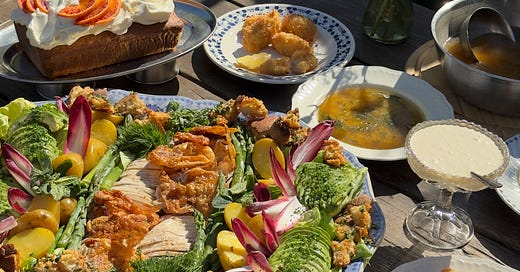



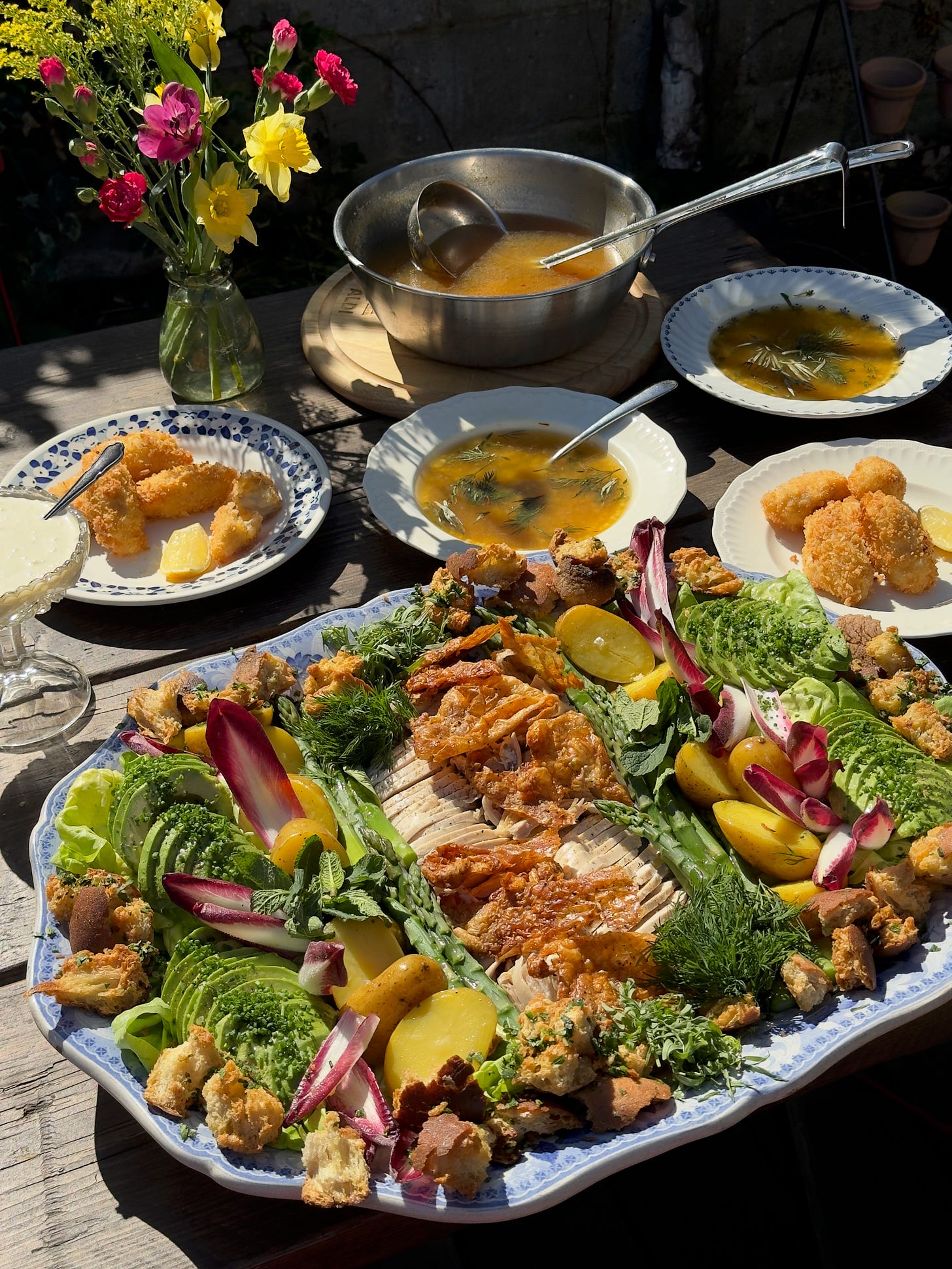
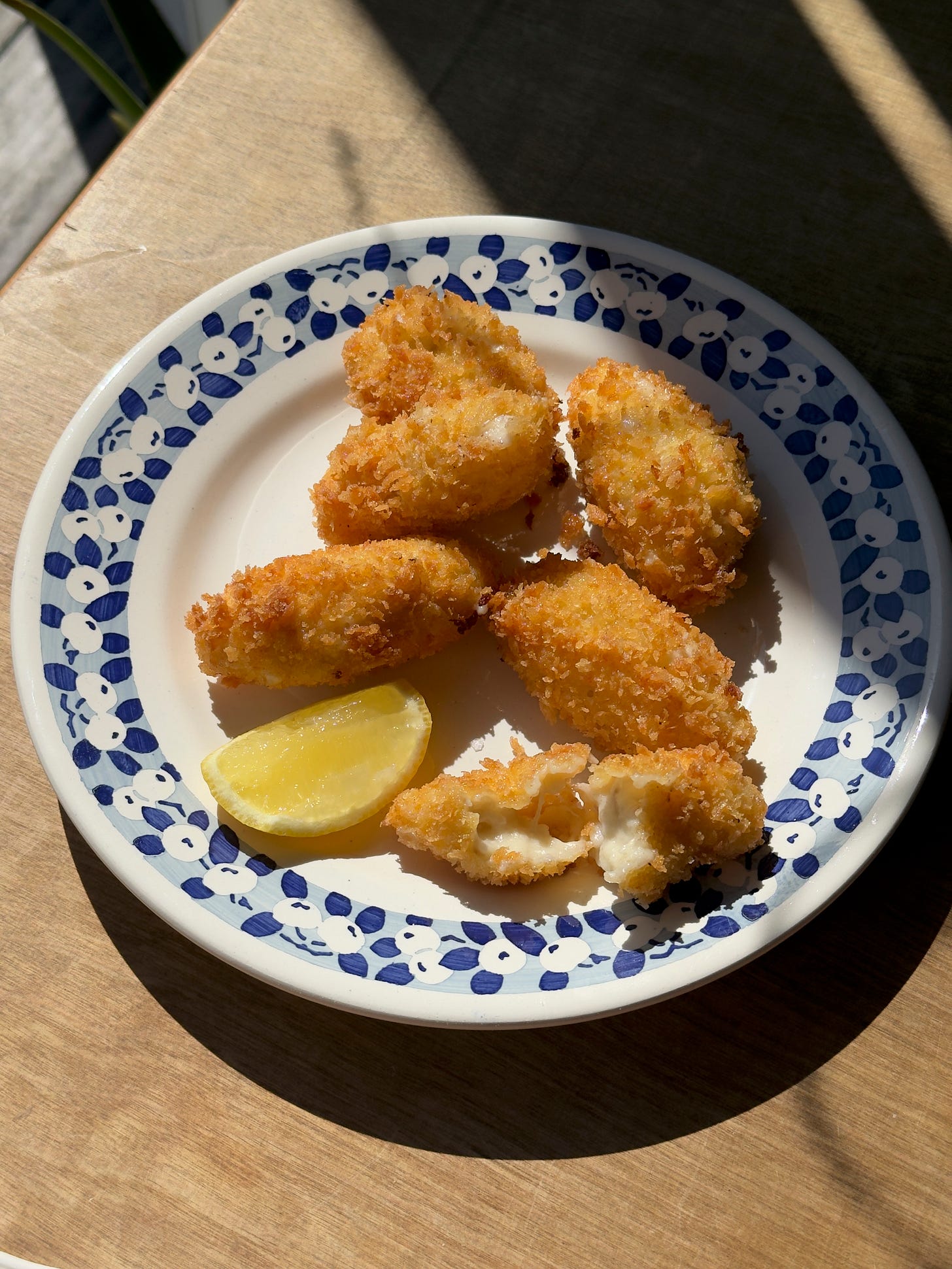
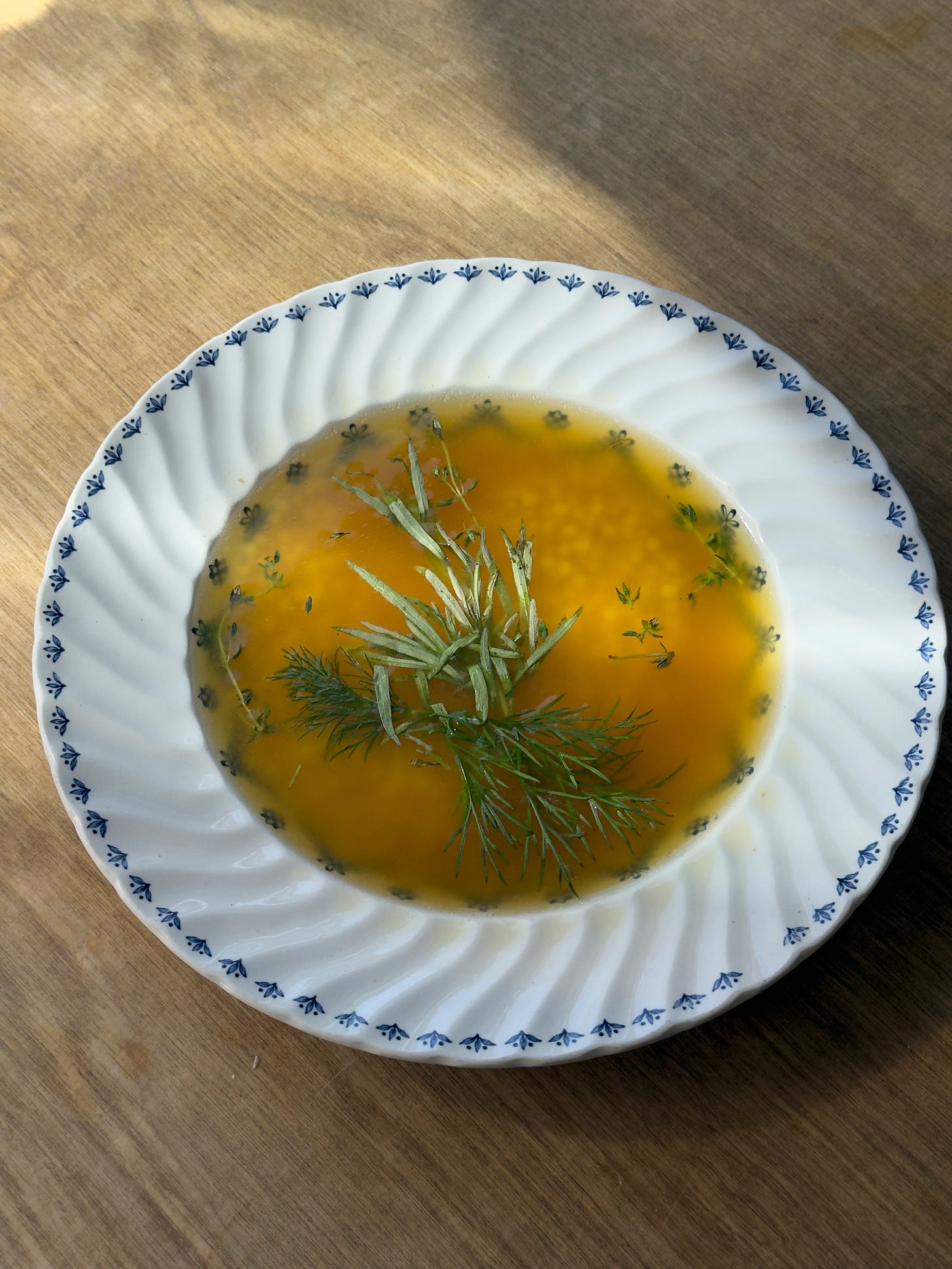
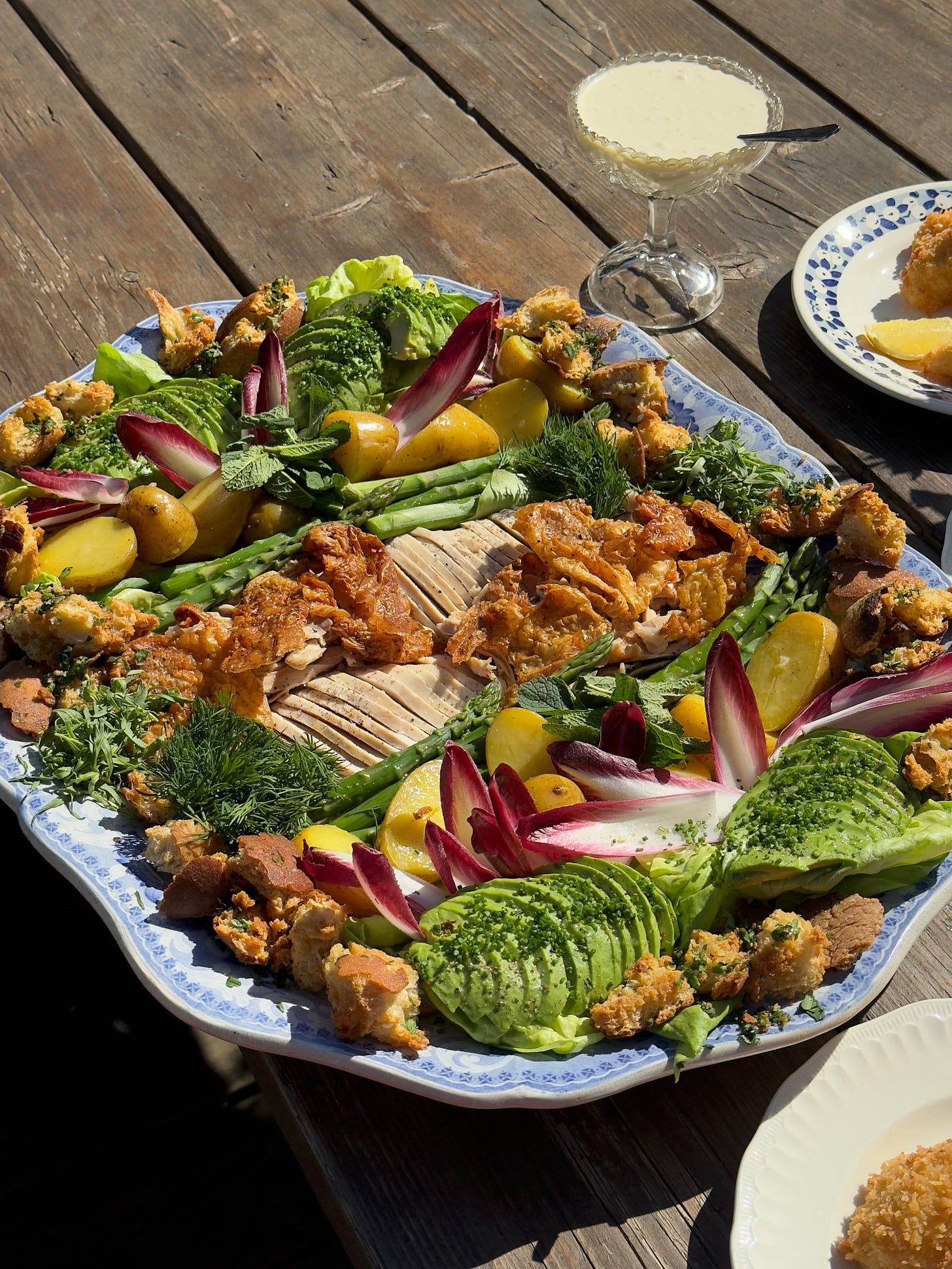
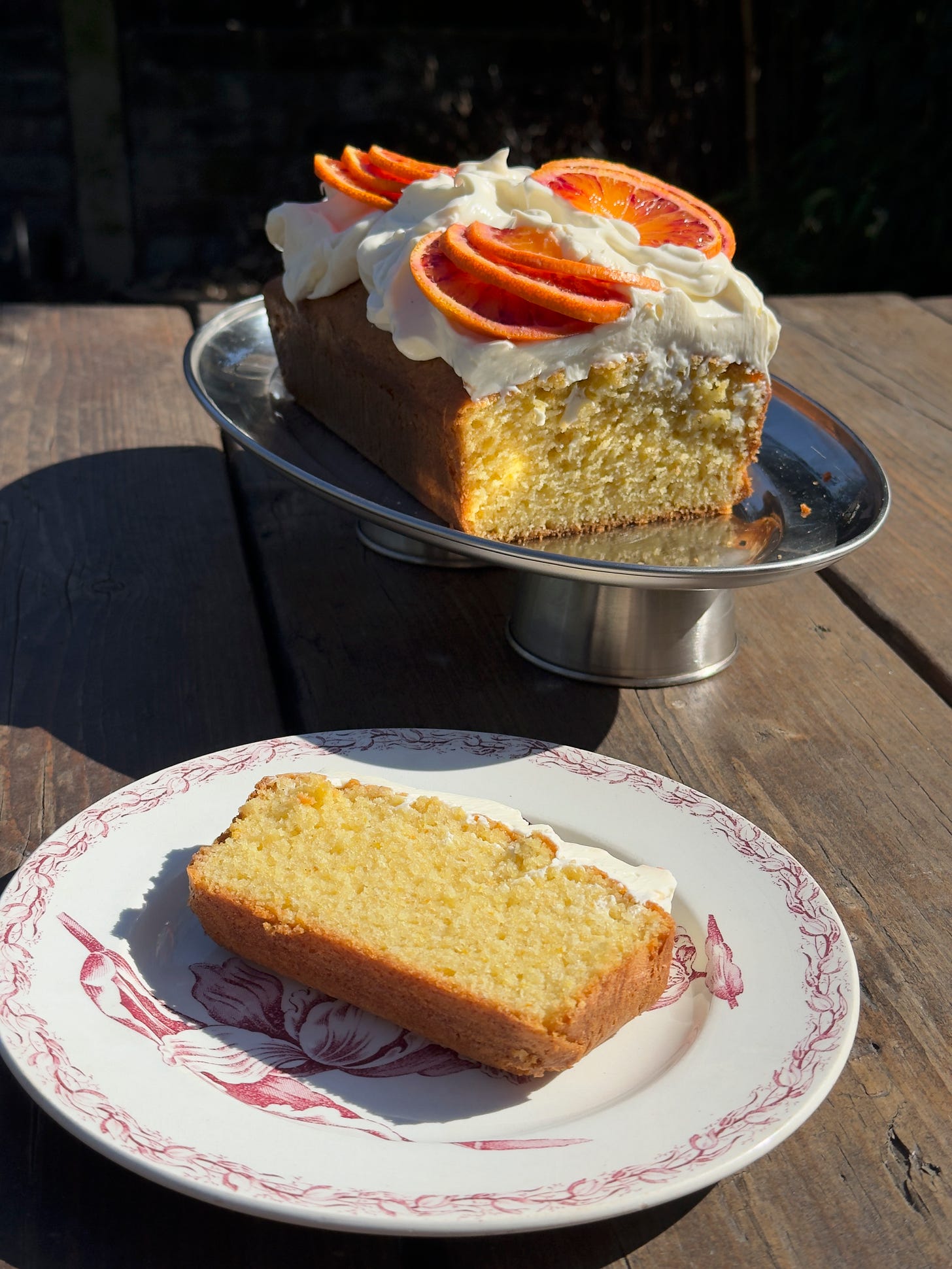
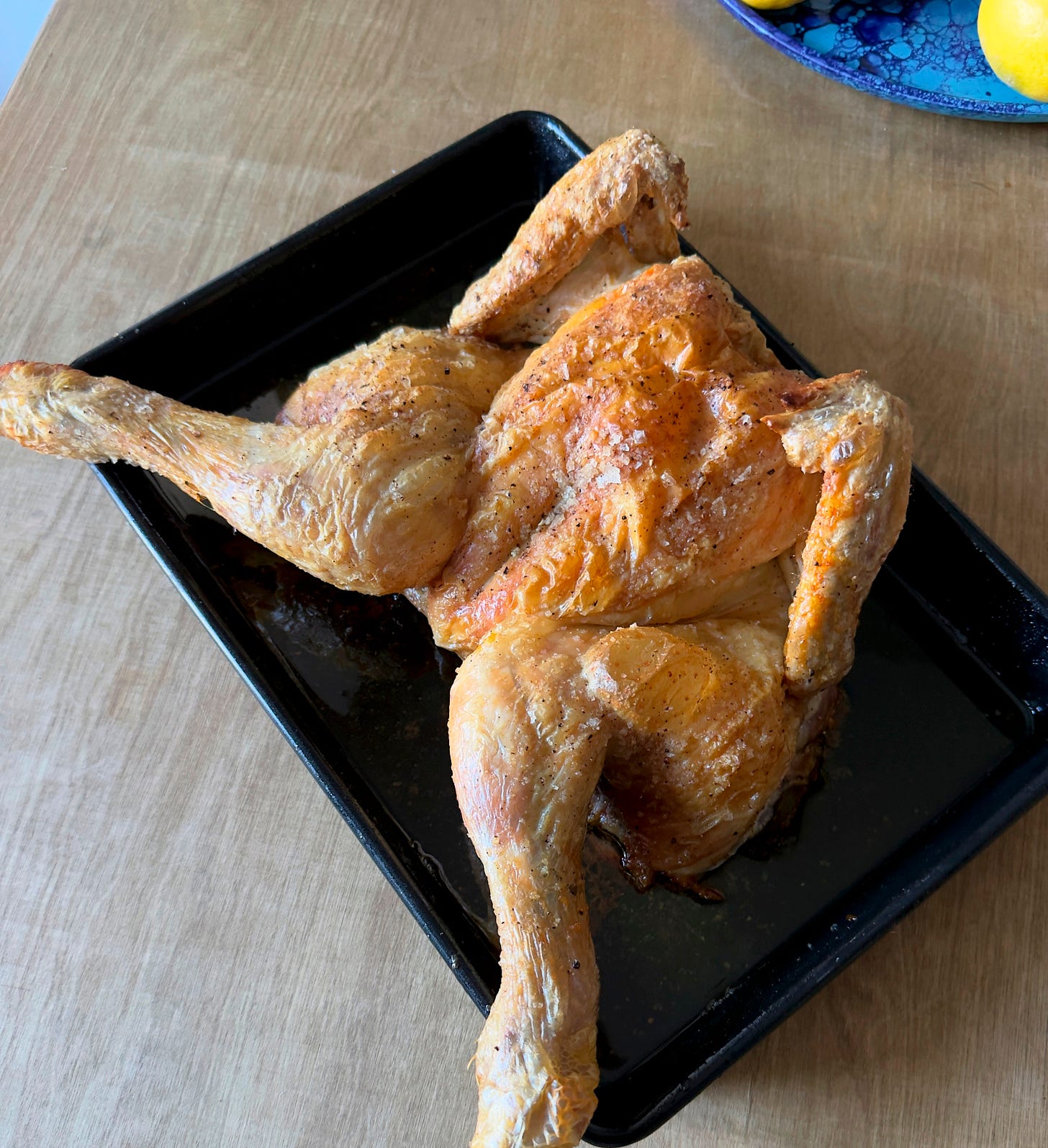
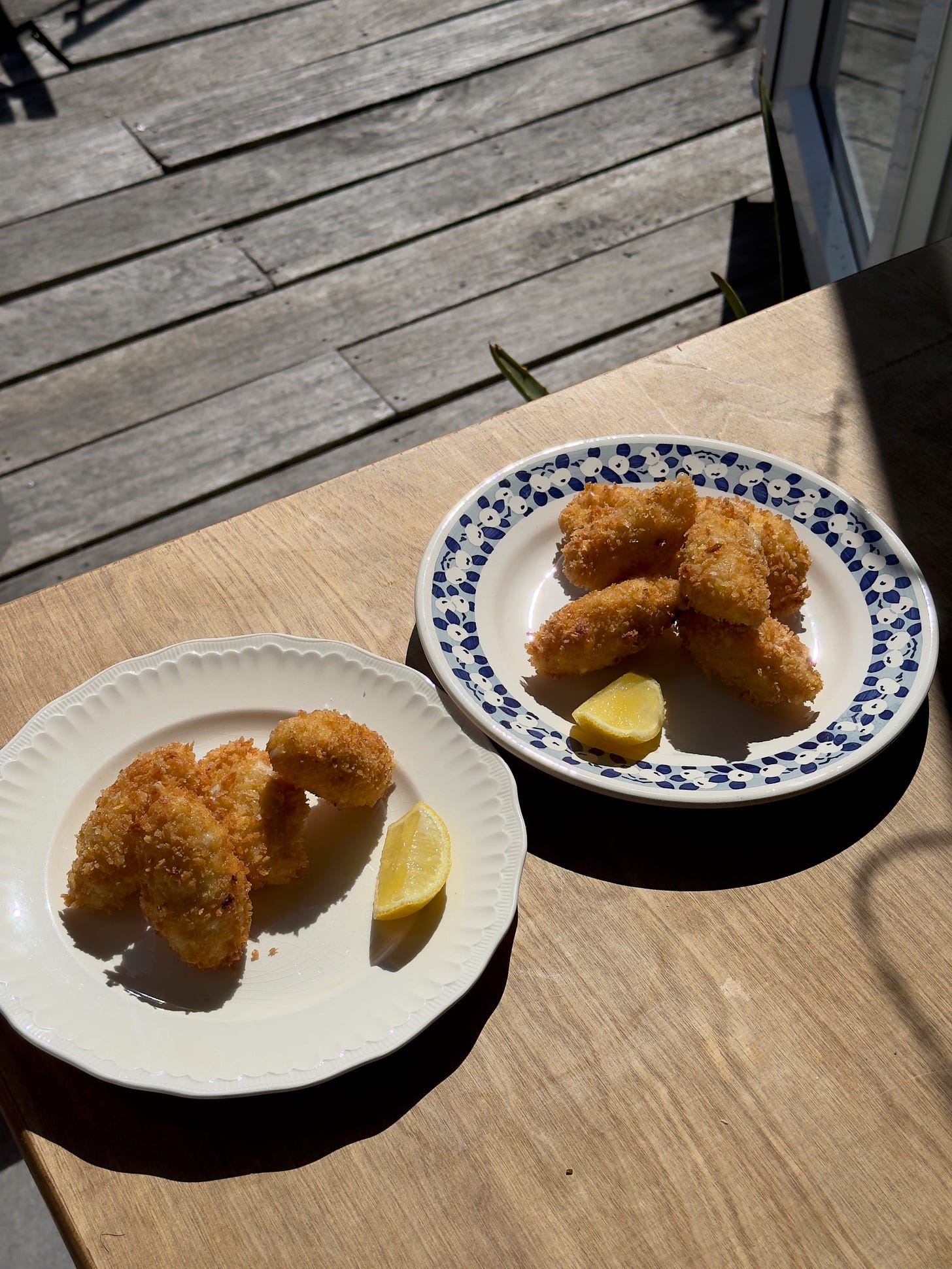
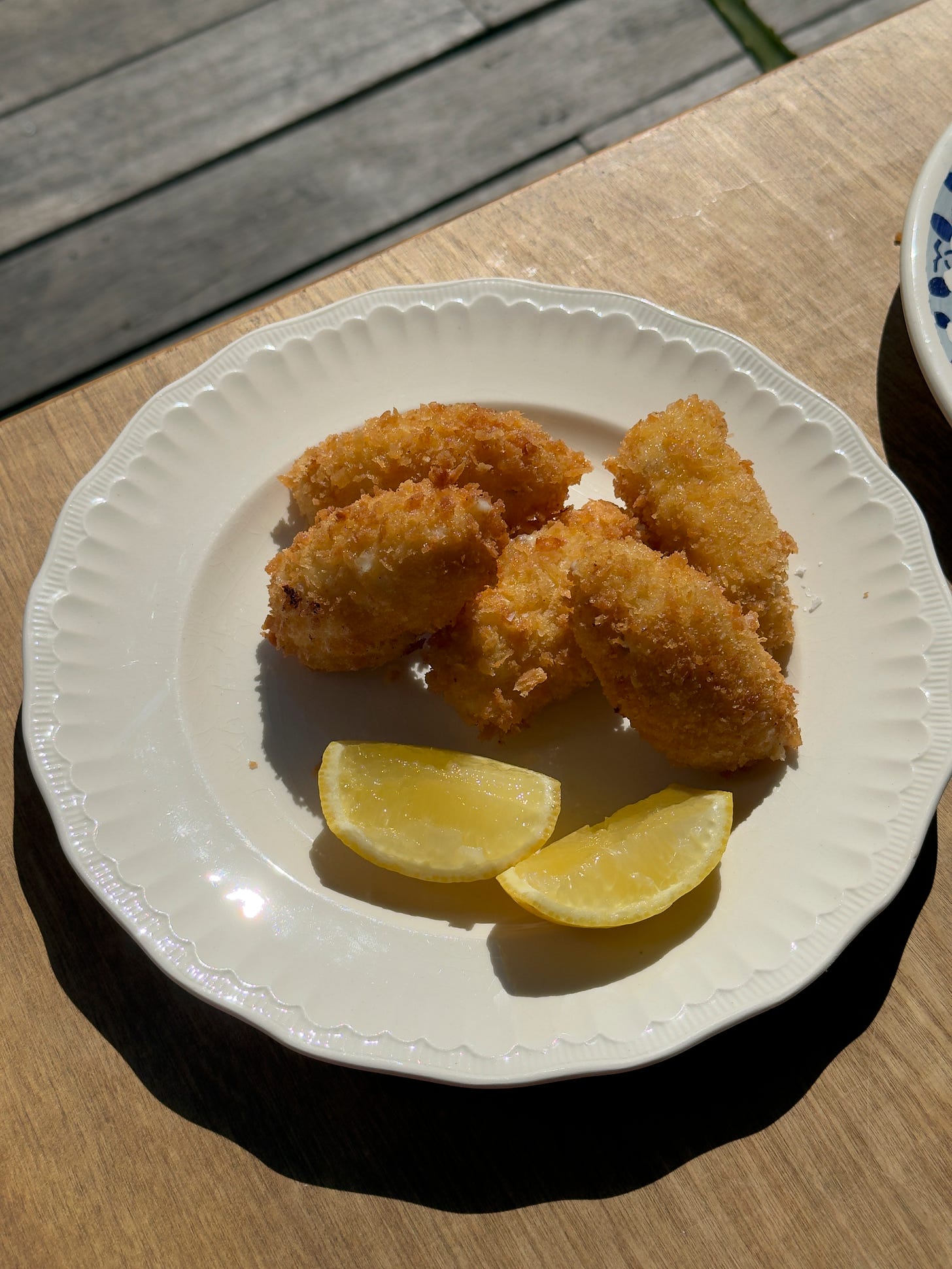
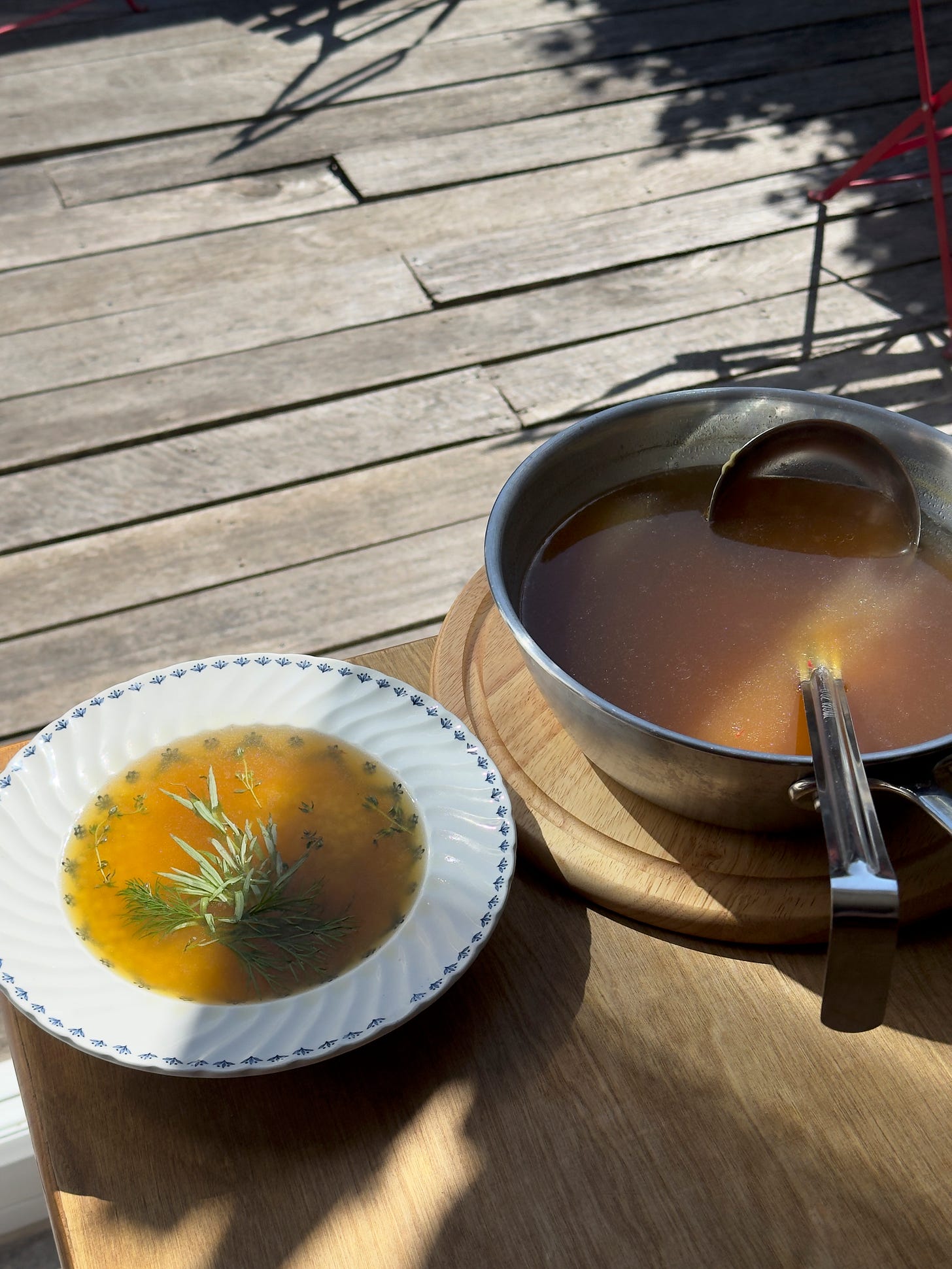
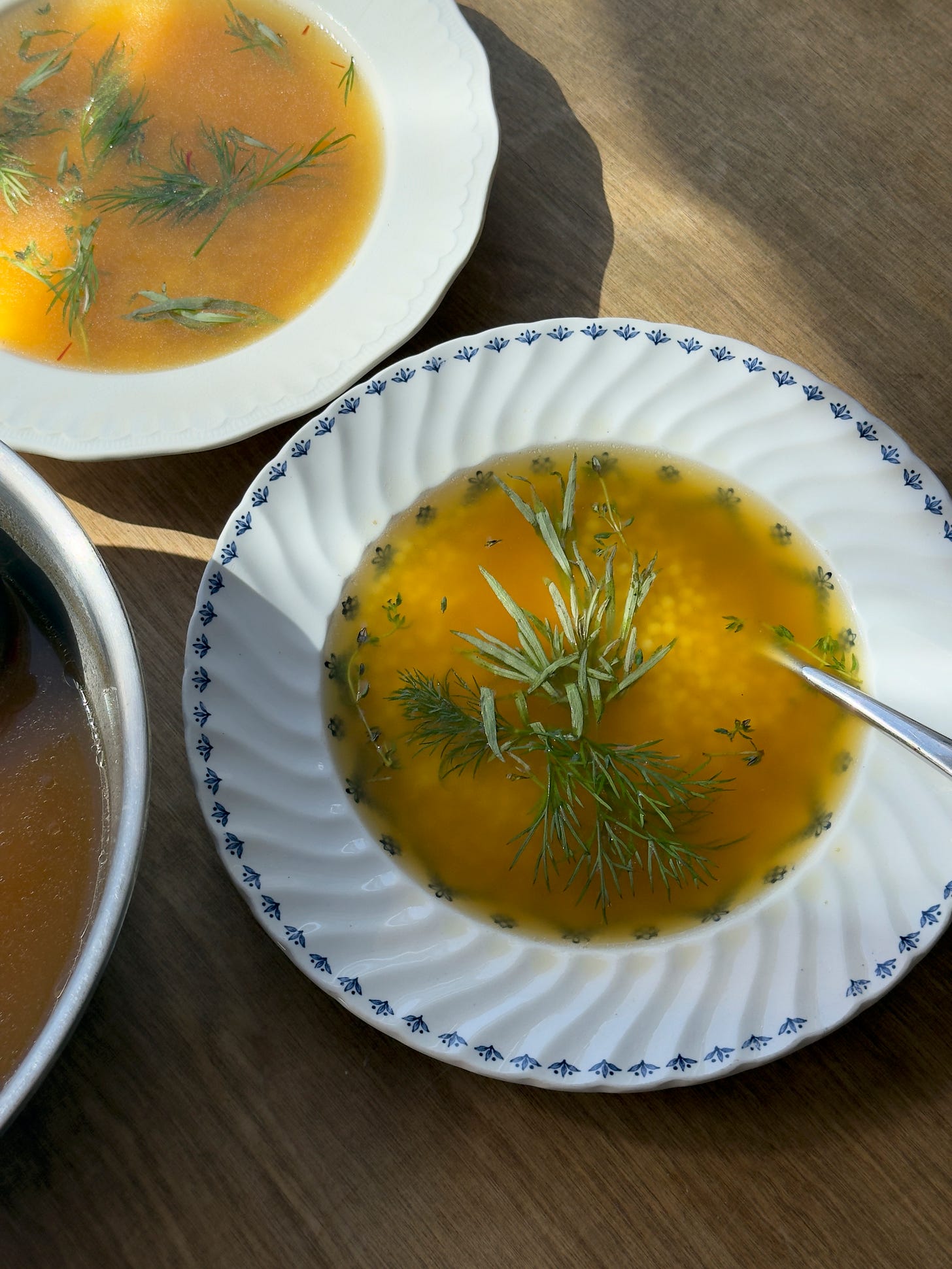
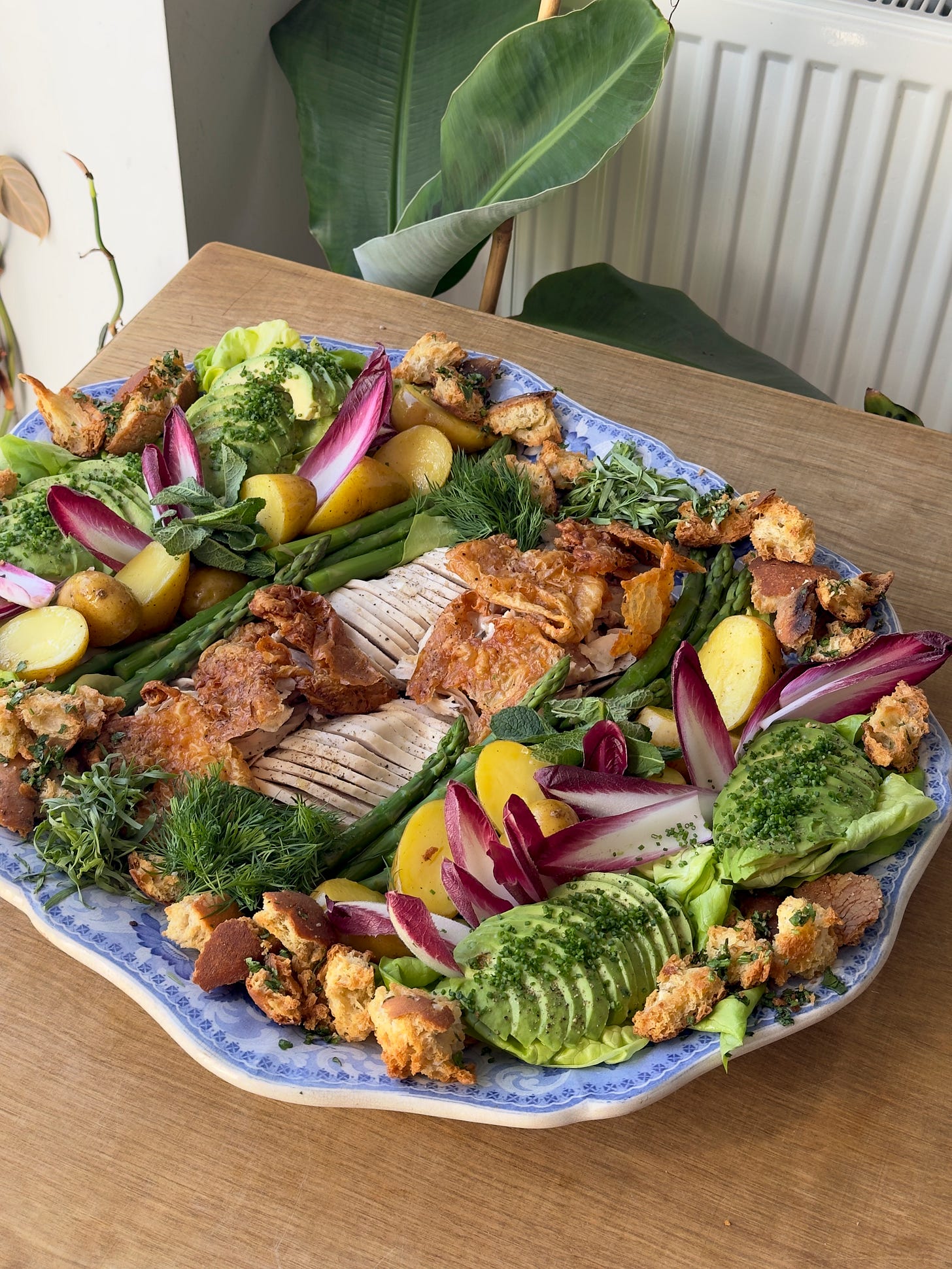
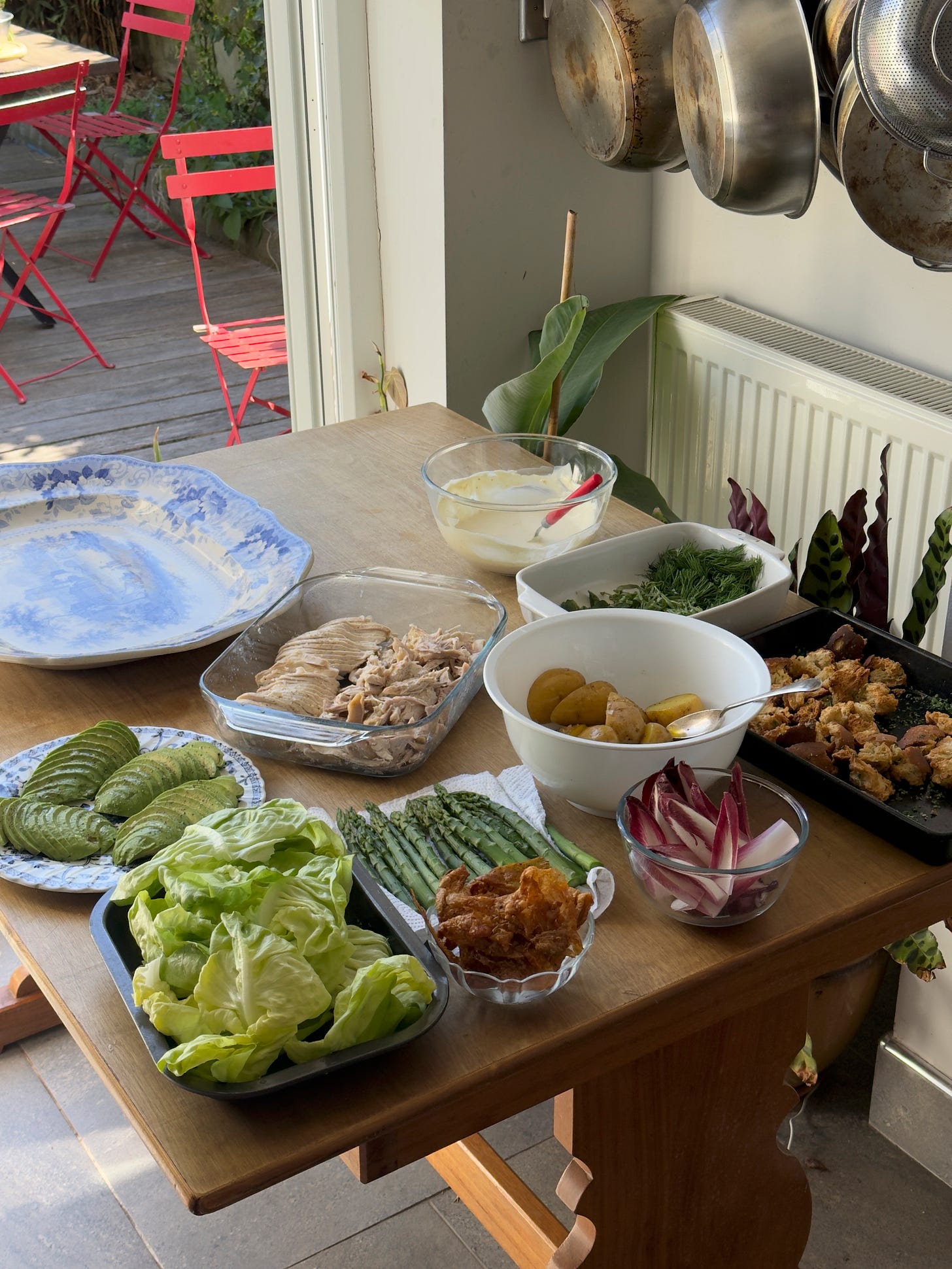
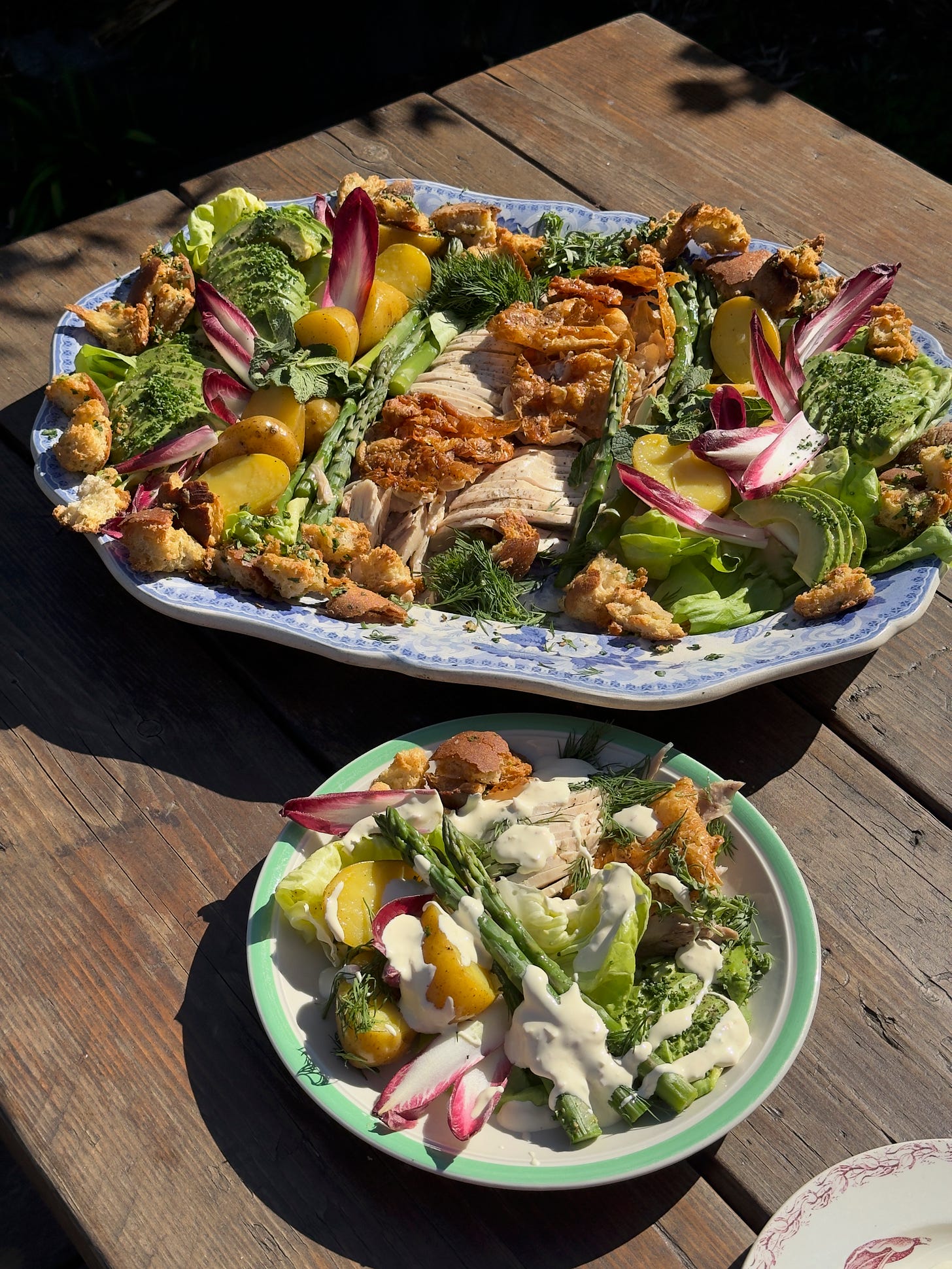
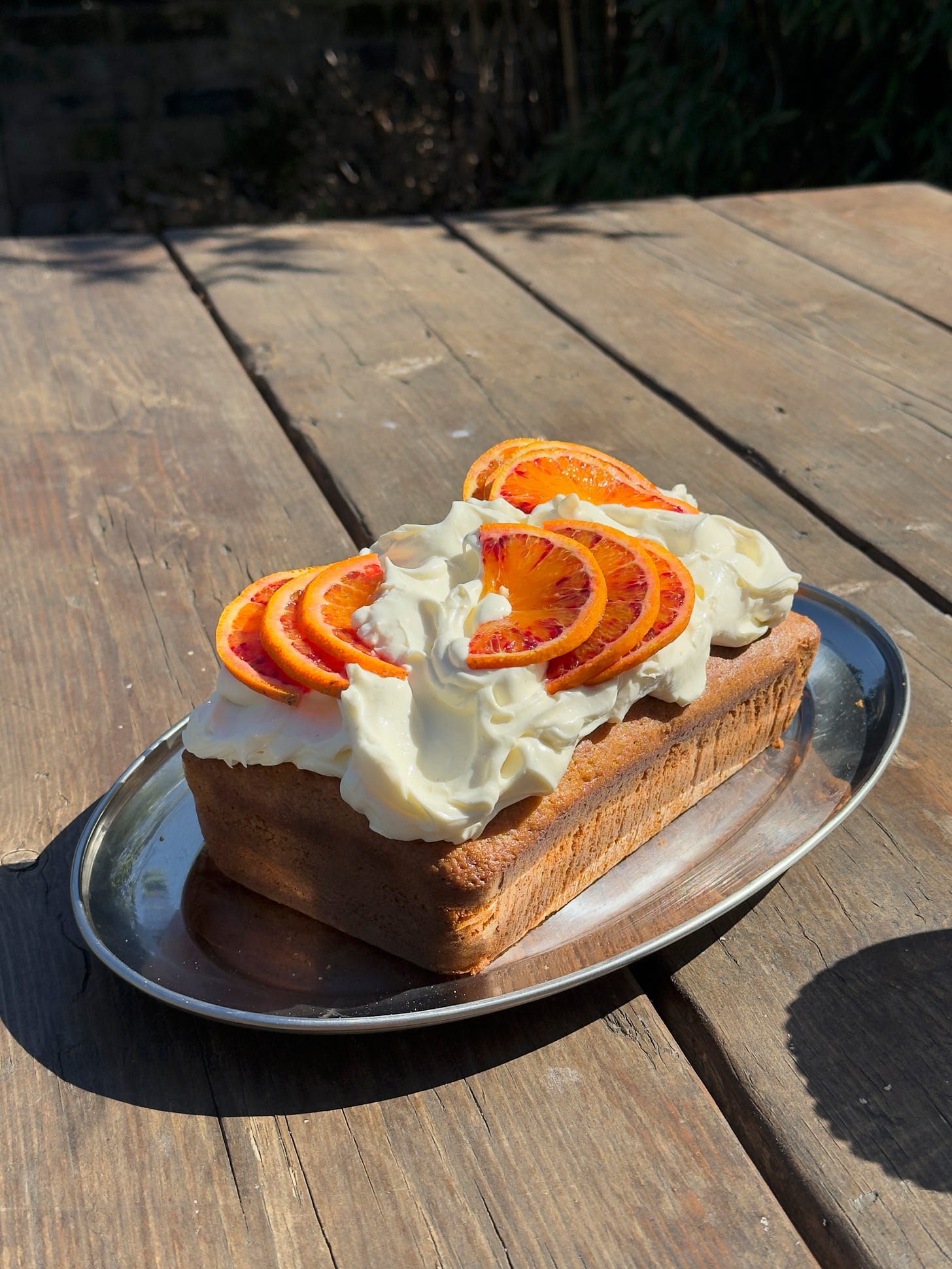
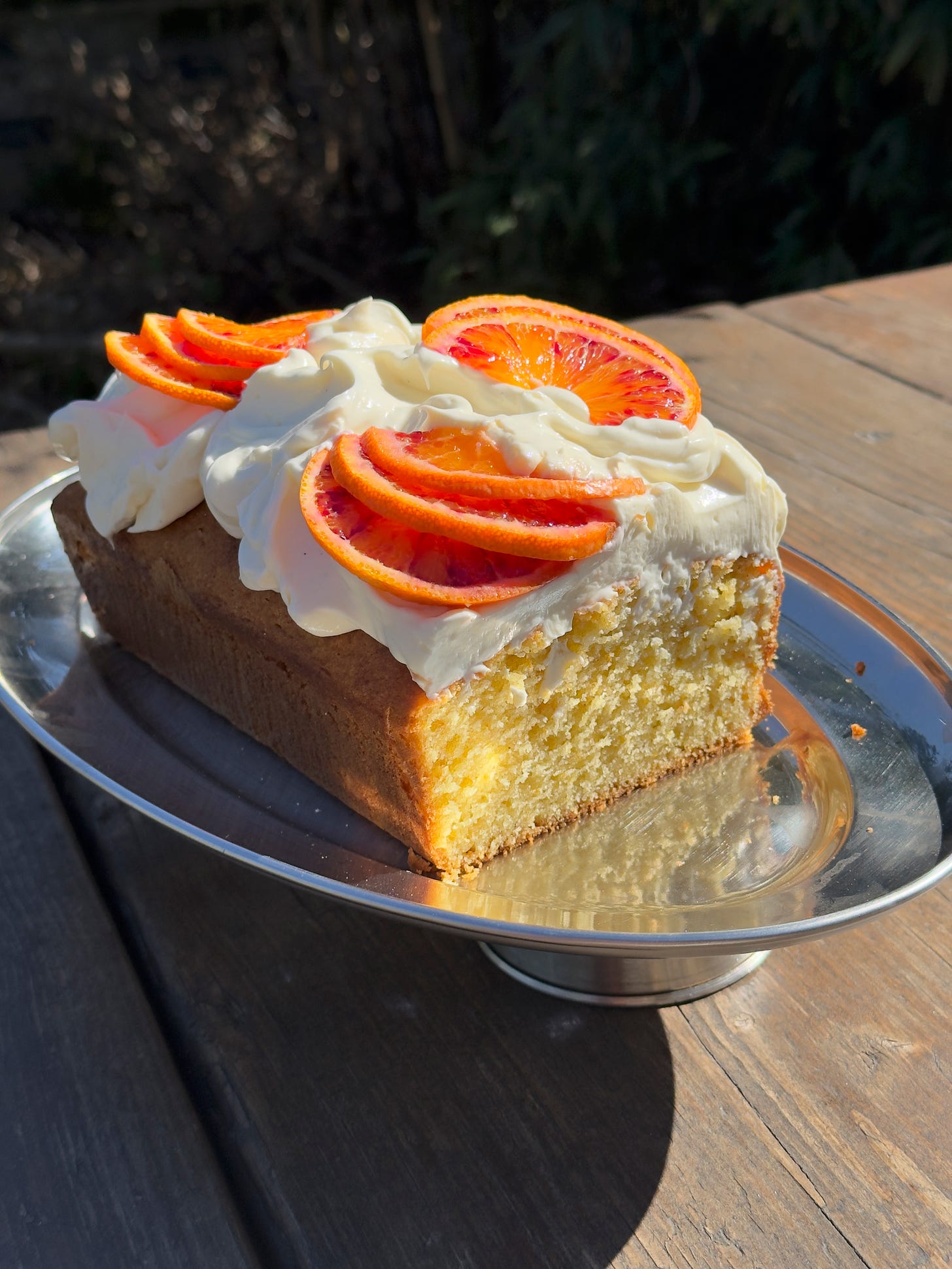

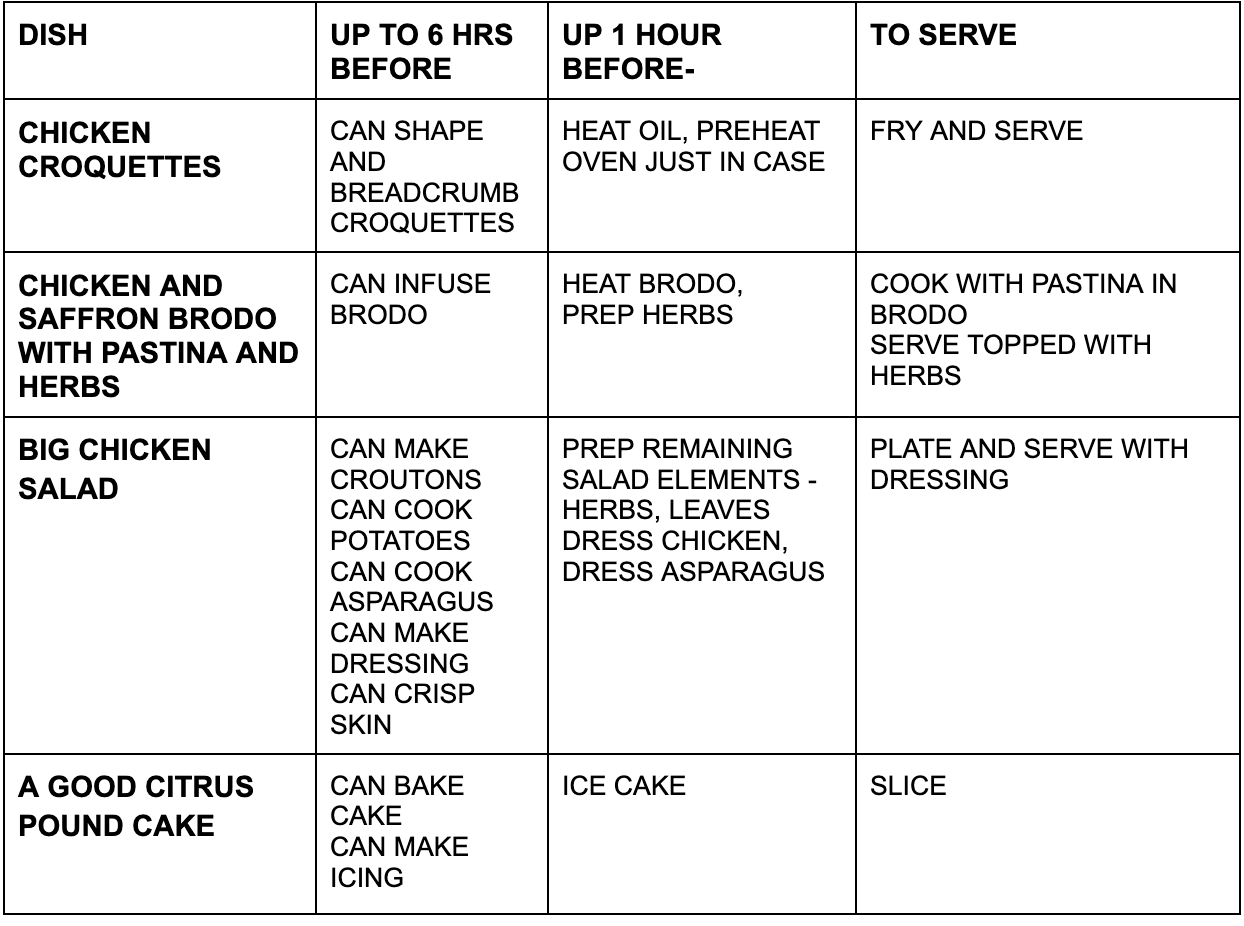
Thank you so much. This looks absolutely delicious...and do-able!
Thus sounds a fabulous menu - I like the concept too - it reminds me of ‘the supper of the lamb ‘ (even including theological references too!! )